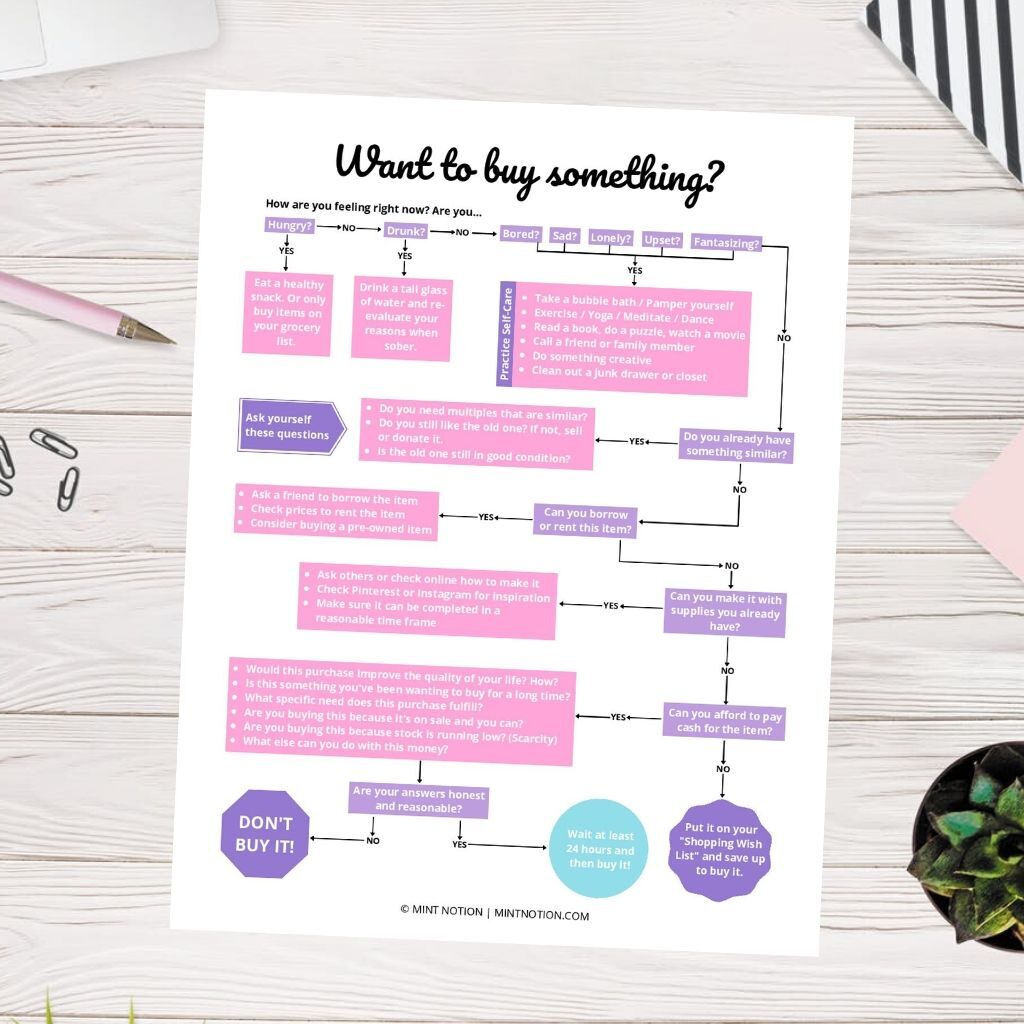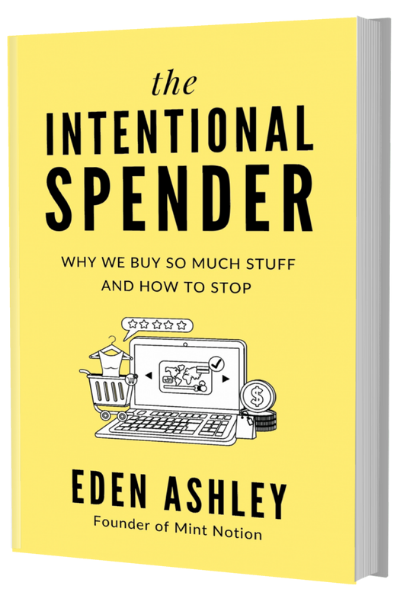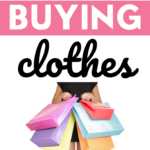What kind of questions do you ask before your buy a product? Below are some things you should consider before making a purchase. These helpful questions can help you shop intentionally and become a more conscious consumer.
Online shopping continues to grow in popularity. Approximately eight-in-ten Americans are online shoppers.
And 67 percent of people say they digital window shop for fun on their mobile phones – with 77 percent of those making an impulse purchase when they do.
When you can instantly read customer reviews, take advantage of exclusive online-only deals, and conveniently have your credit card information already saved on your computer – it’s no surprise that online shopping is on the rise.
Almost every woman has purchased something on impulse, such as clothes and only wore it once or not at all.
It’s easy to come up with many reasons why that cute dress may seem like a good purchase at the time, but ends up something that becomes hidden in the back of your closet.
I was definitely guilty of this! I used to buy fast fashion all the time, especially when my favorite stores were having a sale.
But no matter how many new clothes I bought and told myself “THIS is the last thing I’m going to buy for a while” – I’d always find another excuse to go shopping again and buy more stuff!
Sound familiar?
With my savings quickly disappearing on vintage handbags and clothes, I knew that this was more than just a little harmless retail therapy – I was addicted to online shopping.
That’s when I started to ask questions about fast fashion and realized that it wasn’t adding value to my life.
Table of Contents
Making the switch to “slow” fashion
If fast fashion refers to cheap, trendy clothes that are inspired from the latest catwalk or celebrity styles that gets pumped quickly into stores to meet consumer demand – what is slow fashion?
Slow fashion is a holistic approach to fashion. It considers the process and resources to make clothing, with particular focus on sustainability. Slow fashion means buying quality over quantity.
It involves investing in garments that will last longer, as compared to the immediate gratification of fast fashion. Slow fashion is also known as sustainable fashion or ethical clothing.
When I realized that my shopping habits were having a negative impact on my finances and well-being, that’s when I needed to make a change. So I went cold turkey and did the no new clothing challenge for a year.
During that year I didn’t buy any new clothes, shoes or accessories. Instead I decluttered my clothes, hosted clothing swaps with friends, built a capsule wardrobe using items I already had, practiced gratitude, and started this blog that gave me a healthy creative outlet.
I also watched the documentary called The True Cost, that shares the dark side of the fashion industry.
This was an eye-opener for me, and I recommend checking it out if you’re interested. It helps me to know which questions to ask about clothes before making a purchase.
Shopping with intention
After healing from my shopping addiction, I wanted to help others who were struggling with overspending on clothes and looking to get better mileage from their wardrobe.
That’s why I put together this list of questions so you shop more with intention and be mindful about your purchases.
This may include things to consider before buying something, such as how long to wait before buying something or how decide before buying something for yourself.
I understand that a shopping addiction is unique because it’s not practical to avoid shopping forever. There will be times when you need to buy new clothes or buy gifts for others. That’s why it’s vital to learn how to shop with intention.
If you’ve struggled with impulse spending, it’s not enough to just ask yourself before buying something – “Is this a need or a want”?
Because as a former shopaholic, I was an expert as disguising my wants as false needs. I was able to come up with a laundry list of reasons why I “needed” something.
This question wasn’t helping me improve my spending habits or addressing the reason WHY I was shopping in the first place.
Can you relate?
That’s why when I was writing my e-book, The Intentional Spender, I wanted to cover shopping questions that dive deeper and help you understand what’s really driving you to make a purchase.
Today I’m sharing 12 important questions to ask yourself before buying something. If you answered yes to questions 2-7, this could be telling you that there are underlying insecurities that need to be resolved within.
While it might feel good in the moment to find that awesome deal or hit that purchase button, no amount of things you buy will ever make you feel “enough”.
The key is to start by accepting yourself as you are now. This is the first step in helping you work towards developing better money habits.
Throughout my journey, I’ve learned that money in the bank is security, independence, and the freedom to have options.
If you want to learn more about how to overcome a shopping problem, check out my free audio training.
Questions to ask before buying something – FREE Flowchart
I thought it would be a fun idea to turn these questions into a flowchart illustrating how to shop with intention. I am definitely a visual learner, which is why I LOVE using printables to help me stay motivated and organized.
How it works: Download and print this flowchart at home. Next time you want to make an unplanned (impulse purchase), use this flowchart to help you shop with intention.

You can download this free flowchart by entering your information below!
If you like this flowchart, I would love for you to share it with someone you think would find it helpful. Thank you! I appreciate your support.
With all that said, here’s 12 deep questions to ask yourself before buying something.
1. Why am I here?
Am I shopping because I’m bored? Feeling sad? Lonely? Drunk? Hungry? I had a bad day? I’m just passing the time?
2. Are you buying this for your fantasy self?
Or non-existent version of yourself that you wish to be, such as more attractive, worthy, smarter, badass, and so on? This is one of my favorite questions to ask yourself before buying clothes.
Read Next: Decluttering my fantasy self (and embracing minimalism)
3. Are you buying this because of scarcity?
Such as it’s the last one in my size, stock is running low, limited time offer, the sale ends soon!
4. Are you buying this just because it’s on sale and you can?
For example, it’s only $20 – I can’t pass on such a great deal! Only buy it if you actually love and need the item. Don’t just buy something because it’s on sale and you need a quick pick-me-up.
5. Are you buying this to have some sense of control or permanence in your life?
Shopping can be an intensely emotional experience, which is why it’s important to think before you buy.
While studies have shown that buying stuff or just imagining that you’re buying stuff can help restore a sense of control, this is just a short-term, band-aid fix.
Instead, it’s important to understand the underlying trigger that causes this feeling or lack of control. This can help you gain a sense of control without getting caught up in the vicious cycle of stress spending.
6. Are you buying this to escape from your daily life?
Advertising does a good job at making us believe that buying products will make us happier and improve our lives.
However, studies have shown that viewing desirable goods actually increased people’s materialistic concerns and led to a heightened negative affect (unhappiness).
Buying stuff as a form of escapism from daily life or to fill a void is only a band-aid solution. And turning to retail therapy can make us feel lonelier over time. It’s important to address underlying issues that are causing the unpleasant emotions that we’re feeling.
7. Are you buying this for external validation?
If you’re like most people, you care a lot about what others think about you. This isn’t a bad thing, but it can make you vulnerable to others because we are constantly trying to project an image of ourselves based on what we think others want. But the truth is – we don’t really know what others want.
The need for external validation can also lead us to “keep up with the Joneses” or wanting to maintain social status by having material things.
However, using material things to boost our confidence will only provide a temporary sense of security and make us unhappy in the long run.
According to a recent study, 78 percent of Americans are living paycheck to paycheck. This means that the Joneses are broke because 8 out of 10 people probably can’t afford the car they’re driving or the home they’re living in.
I know it’s easy to get caught up in comparisons and trying to chase someone else’s life instead of enjoying your own. But it’s important to remember that only YOU can decide how you want to spend your money and live your life.
8. Do I already have something similar? Does it need to be replaced?
If you already have something like this item, then you probably don’t need to add it to your wardrobe.
9. Will this go with other pieces in my wardrobe?
Buying something new should not mean that you need to buy a bunch of additional items to go with it.
Visualize your current wardrobe and ask yourself – what would you wear with this item? If you can visualize multiple ways to wear the item with what you currently own, then consider buying it.
If you can’t imagine wearing this item with anything you currently own, then it’s probably not a good idea to buy it.
10. Does this align with my personal style or is it just a trend?
I know it’s fun to wear trendy clothes, but if it doesn’t match your personal style, it’s most likely not worth buying.
When deciding if you should buy the item or not, imagine different scenes from your actual life – going to work, relaxing at home, going to the gym, dinner dates, weekend adventures, and so on.
For example, if you work in a corporate office and rarely go to the gym, it probably doesn’t make sense to buy a bunch of athletic wear.
11. Will I use this at least 30 times?
It’s important to consider the lifespan of the item. Try to think of at least five occasions off the top of your head where you’ll use this.
When you buy items that you truly love and will wear multiple times, that’s when you’ll be on your way to building the closet of your dreams.
If you need an outfit for just a one-time occasion, consider renting it or borrowing it from a friend instead of buying it.
12. What else can I do with this money?
Does it really need to be spent on this item? Or would you rather use that money to help pay off debt or put it towards a fun vacation? This is a great question to ask yourself before making a big purchase.
Every little bit helps you get closer to your financial goals!
Introducing: The Intentional Spender

In The Intentional Spender, you’ll learn insider secrets on how to conquer your impulse spending for good. As a former shopaholic, I know all too well how emotions can easily influence your spending.
Studies show that is takes 21 days to form a habit. That’s why I’ve put together this 21-day program to help you form and implement healthy spending habits. This includes shopping with intention, living within your means while still having fun, and feeling comfortable and confident with your personal style.
I don’t believe in depriving yourself or living on a bare bones budget! I believe that you are 100% capable of transforming your mindset by discovering the root cause behind your spending habit and developing a game-plan that actually works.

